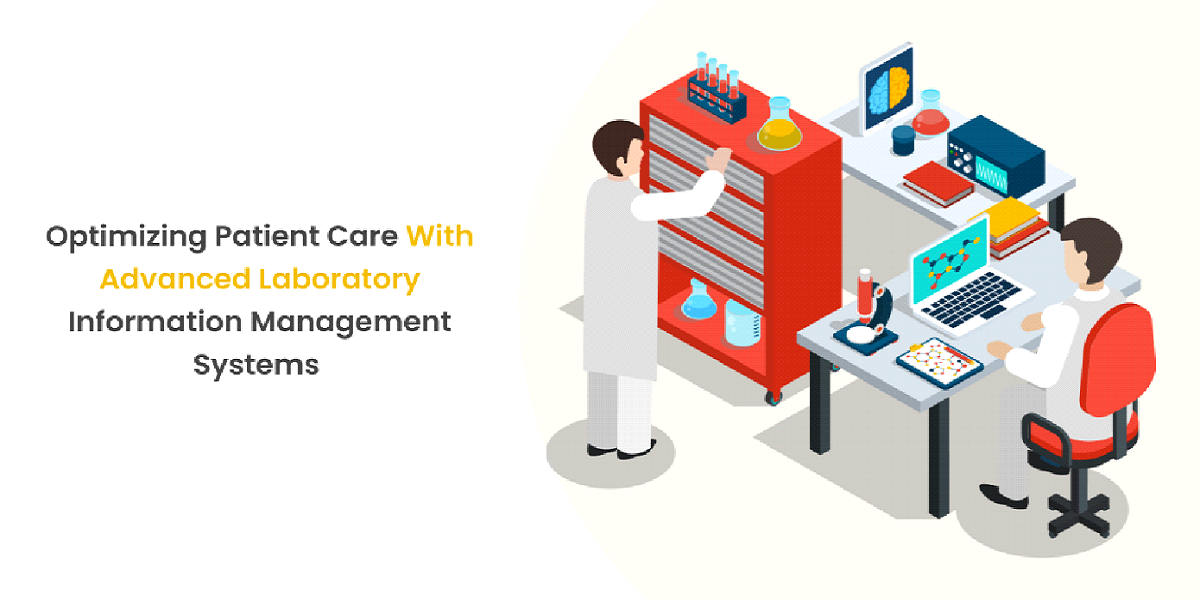Optimizing Patient Care with Advanced Laboratory Information Management Systems

Enhancing patient care involves the management of medical information and to a great extent, this is facilitated by the LIMS. A Laboratory Information Management System facilitates rapid decision-making by managing laboratory operations and improving test result reliability, as well as making data more easily available to HC professionals. This results in enhanced benefits to a patient which in turn increases the gains for the healthcare system thus propelling the healthcare system.
Understanding Laboratory Information Management Systems (LIMS)
LIMS stands for Laboratory Information Management System; it is a complex solution used to handle laboratory information and maintain effective work. LIMS plays an important role in managing data useful for laboratory testing by sorting, documenting, and storing information about analytical work, which can affect productivity, data quality, and adherence to norms. It acts also as a computerized database of sample data, test results, and other informative data which plays an important role in laboratories' accurate and on-time delivery of results to healthcare providers, researchers, and patients.
In its simplest form, a Laboratory Information Management System enables laboratories to turn paper-based processes into automated ones. LIMS can facilitate every stage of sample registration and its final reporting. It monitors the location of samples in a laboratory environment, records data, orders supplies, and produces reports as well. Through automation of these activities, LIMS minimizes human interference thereby increasing the accuracy of work, and no important information is left out as it may be fatal in some fields such as health.
Besides, the implementation of LIMS has the effect of optimizing the use of data by availing test results and records in real time. This implies that patient information is more readily available to care providers – and this means better and faster decisions can be made. In addition, with LIMS, laboratories can operate in compliance with such legal standards and requirements as HIPAA, CLIA, and ISO, as well as simplify compliance with stringent rules regarding the protection of information, testing reliability, and reporting.
The fourth important advantage of Laboratory Information Management Systems is the fact that it can be interfaced with other healthcare technologies, including Electronic Health Records. This integration guarantees efficient and smooth integration of laboratories and medical practitioners so as to improve patient care resulting from the right and timely tests.
Finally, LIMS is a vital application that modern laboratories cannot afford to live without as it increases efficiency, compliance, and quality patient care.
Role of LIMS in Optimizing Patient Care
Understanding how exactly Laboratory Information Management Systems (LIMS) can contribute to enhancing patient care delivery is now fundamental in the modern healthcare context. Another use of LIMS is in enhancing the delivery of tests in a laboratory since this system is in charge of making the process fast and efficient. In its operations, LIMS decreases the role of human interference and thus enhances the accuracy that healthcare providers need in making the right decisions.
LIMS or Laboratory Information Management System, pathology lab software is used for managing test reports, especially in diagnosis and pathological sectors. It is integrated with other hospital systems, including the Electronic health record so that the reports of the tests conducted will be readily available to the doctors, hence increasing the rate at which clinical decisions get made.
Furthermore, LIMS helps in quick and easy retrieval, fast access, fast security, and fast access to patient information. It is important in these situations due to the fact that accurate results are critical in a critical care situation. LIMS contributes indirectly to the quality of care in a major way by eliminating delays and increasing the accuracy of real-time data.
In the last analysis, the integration of the state-of-art LIMS and Pathology Lab Software refined the complete diagnostic process as well as enhanced patient care and safety aspects, decreased erroneous likelihood, and overall, built a much more competent and sustainable delivery system aimed towards conquering a multitude of discrepancies for generating improved patient outcomes.
Key Features of Advanced LIMS
Current LIMS are sophisticated to provide numerous elemental tool sets that make laboratory management more effective, particularly in the dimension of health care delivery. One of the highlights attributed to the proposed system is the real-time monitoring and data analysis feature, to guarantee fast processing and accuracy of results in the laboratory to enable quick decisions for the treatment of patients. It is crucial in pathology labs because the timeliness of the results could make a big difference in the patient’s prescribed treatment plan.
Another essential aspect by which integrated LIMS in healthcare is electronic health records commonly abbreviated as EHR. It guarantees clear interaction between the lab as well as other doctors and other healthcare givers as test outcomes can be viewed and accessed straight from the patient record. Even with the Pathology Integration Construction, this is taken to a further level, offering pathologists and doctors ways to track patient progress and history.
Other features that concern all modern LIMS are automation and the elimination of errors. It is described that the use of automated workflows negates the requirement for data input from results and therefore minimizes the potential for errors. Also, the current sophisticated LIMS has reporting features that enhance the visualization of the data collected and enable decision-making and quality control.
Collectively, these features put LIMS at strategic leverage in the healthcare sector enhancing organizational productivity, reliable data, and enhanced patient care.
Benefits of LIMS in Patient Care
LIMS systems are invaluable tools in delivering patient-centered care, integrating information from the laboratory, enhancing the quality of the results, and increasing multidisciplinary collaboration. Here are some key benefits of LIMS in patient care:
1. Improved Accuracy and Efficiency
LIMS Play In Healthcare minimizes errors as a result of manual input, sample tracking, and report generation. This means that there are no distortions when it comes to the results of the test Besides, the tests are processed in the shortest time possible. Availability of data at higher speeds and increased efficiency leads to enhancements of treatment plans to be done on the patients since it is faster and more accurate.
2. Enhanced Patient Safety
LIMS guarantees that laboratory information is not only safely transmitted to the caregivers but also is completely accurate. This is ever so important in healthcare as it drastically minimizes the risk of lost or misinterpreted results that can lead to fatal mistakes. LMIS makes test results easily accessible for the medical team due to which interventions are quick and patient safety enhanced particularly in emergencies and complications.
3. Better Coordination Across Healthcare Teams
LIMS provides interconnectivity of EHR, allowing doctors, nurses, and specialists to have access to the inline lab data. Such connectivity guarantees each of the members of a particular team is informed and, therefore, minimizes circumstances where there could be confusion concerning a patient’s status.
4. Faster Decision-Making
In LIMS, results can be easily obtained in real-time and this would mean that doctors can quickly decide on issues to do with diagnosis and treatment. Efficiency accelerates wait times, allowing for early treatment that benefits the client.
5. Optimized Healthcare Operations
Because LIMS eliminates much-paper-based and other repetitive work assignments, it helps to save time and manpower in labs and other healthcare units. This all leads to better-working healthcare and happier patients and providers throughout the process.
Data Management and Patient Safety
In today’s world, the safety of the patient is a top priority, and data management is no longer an option but a necessity in today's healthcare services delivery system. One of the important facilities that contributes to changes in this sphere can be considered the Laboratory Information Management System (LIMS). LIMS is an application that is intended to optimize the operations of a laboratory, increase the speed and accuracy of data handling as well as improve the quality of patients’ treatment. The adoption of LIMS can make a great contribution to increasing the meaning of patient data by increasing its accuracy, availability, and protection in healthcare systems, hospitals, and labs.
LIMS helps the laboratories store, track, and retrieve every result with ease and accuracy so that the doctors will be equipped with the latest information. Increased speed and accuracy from this real-time access to data lowers the risk of errors, which are the result of manual data entry, and delayed information transfer, and, which affects patient safety. In addition, LIMS also helps to organize a tremendous volume of data in a properly arranged form to ensure that healthcare companies can easily monitor the information of various patients to identify significant concerns in the early stage.
Regarding patients, the safety of data and their security are significantly important. LIMS makes it possible to securely store all the important and private data concerning the patient, for example, test results, diagnosis, and further treatment plan, to access them, one has to have proper permission given by the specific software. This assists in minimizing chances of invasion of the privacy of individuals, loss of information, or hacking of important information. Also, in LIMS, there are options where it could alert possible differences which enables the healthcare givers to seek to correct them before impacting the interests of the patient.
Lastly, improvements in data management for Laboratory Information Management Systems result in decision-making with more efficiency. This enhances the treatment accuracy taking care of the patient’s safety is something that makes LIMS an important tool in any environment that has to do with health care. By increasing the aspects of automation, integration, and improving data handling, LIMS makes patient care more secure and more effective.
Regulatory Compliance and Standards in LIMS
The healthcare and laboratory industries for instance require government standards to provide the best services that will help patients and other consumers. For laboratories to be in a position to meet these regulatory standards as well as work more closely and efficiently, a Lab Management Information System (LMIS) is essential. These systems are intended to follow rules and regulations stated by different authorities where laboratories need to follow the standard procedure to maintain accountability, security and integrity.
This organization has identified the fluency of healthcare standards including the guidelines of the Health Insurance Portability and Accountability Act (HIPAA) and the Clinical Laboratory Improvement Amendments (CLIA) as one of the main concerns of laboratories. This is because a Lab Management Information System is developed to meet these challenges with viable automated solutions that enable labs to adhere to data security and quality control standards. For instance, role-based access control, encryption, and audit trails make sure that patients’ data is well protected and only accessible to persons with permission.
Furthermore, the LMIS platform assists laboratories in meeting regularity requirements for documentation of test results and report accuracy, together with the validation process. The system can alert discrepancies when there are troubles, or something is off from the standard procedure to follow when conducting the tests by the lab technicians and report on results as expected. This helps avoid mistakes and this is very important to maintain patient safety and to make the right treatments based on correct data.
One more advantage of such a solution is the possibility of its usage to enhance the accreditation process. Essential in avoiding hitches and offering ready information during audits and inspections is the automated provision of reports, the recording of test result histories, and record keeping. This relieves the laboratory workers from a lot of work stress and allows mostly important work to be done, including the care and testing of patients.
Improving Lab Efficiency and Reducing Errors
It is understandable that laboratories are very significant in healthcare delivery systems and any effort aimed at enhancing their productivity and reducing errors islam. There is no better way of achieving this than having a Laboratory Information Management System (LIMS). Due to the automation of monotonous activity and fast working, LIMS has reduced the impact of manual errors and fastens the workflow.
Since sample tracking is one of the key benefits that a LIMS provides, the tracking of each sample both in storage and in analysis becomes a real-time function. This helps to eliminate cases, where a sample may be misplaced or even lost, which in turn causes delays and expensive mistakes. Through data entry, LIMS also helps reduce ‘typographical errors’ on the results from tests performed and entry of results is also well noted.
Also, LIMS enhances specimen connectivity of laboratory personnel in addition to clinicians, by providing active access to test data and patients. That assists clinicians to reach faster, more accurate decisions so that the treatment is timely, and patients improve. It also has automated alerting and validation checking, which can highlight potential differences in test readings or workflow issues in order to influence the patient’s treatment.
If processes are automated, the data is made more accurate, and communication is made clearer then it is easy to see that a Laboratory Information Management System makes lab processes run more efficiently while minimizing risks for errors and improving the delivery of health care.
Conclusion:
In conclusion, improving the identification of the patient as well as the operation of the Laboratory Information Management Systems (LIMS) helps to become an important factor in better healthcare delivery and precision. In general, LIMS in the field of pharmacy and many other related fields result in faster, more accurate, less erroneous test results that enhance the care being provided to the patients.
Hyperlink InfoSystem - Most Trusted End-to-End development Solution Provider.
Write For Us





